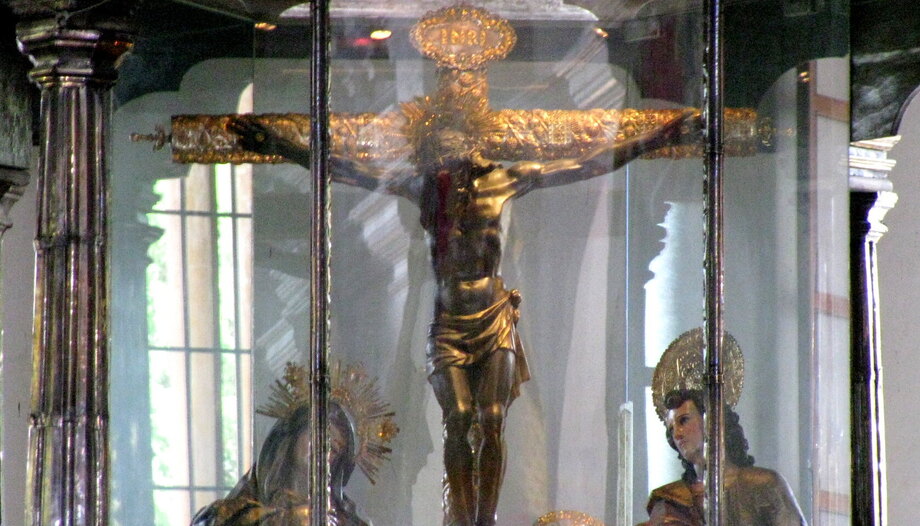Every January 15, Guatemala celebrates the feast of the Black Christ of Esquipulas, a city located 222 kilometers from the country's capital. This feast attracts to Esquipulas about four million pilgrims from different parts of Guatemala. They come to give thanks or ask favors to the Black Christ.
Around that date, processions, novenas, Masses, as well as diverse cultural expressions that express the faith and popular piety of the villagers take place in that town. The devotion spreads in several countries of Central America and the United States, because the image contributes to increase the fervor and piety, but it is also an element of identity and social cohesion outside the country. Guatemalans find in the Black Christ a factor of union and attachment to their traditions and culture.
The image of the Black Christ
The image is a sculpture of the crucified Christ made in the XVI century in polychrome wood. Its authorship is attributed to the sculptor Quirio Cataño. There are many versions and legends about the dark tonality. There are no manuscripts that refer that the original color of the wood was totally black, the certain thing is that the smoke of the candles, the candles, the incense, the dust and the hands of the pilgrims have contributed to its darkening.
According to some researchers, the black tonality of the Christs or Virgins in America is attributed to four factors: religious syncretism, the materials of the pieces (based on cane paste, corn and dark woods), the demand for representations that evoke a sense of belonging and the Afro-American community in New Spain.
Since the 18th century, the clergymen of the Sanctuary of Esquipulas sought to channel popular devotion and connect it with the dark tone of the image. For example, Canon Juan Paz Solórzano wrote in 1914: "When the hour of the Passion arrived, Christ walked to Calvary under a burning and embracing sun, amidst a cloud of dust produced by the throng of the impious mob that followed Him. Whence then, this admiration, on seeing the sacred image represented under a dark shadow?"
In this regard, during his visit to the shrine of Esquipulas on February 6, 1996, John Paul II He pointed out: "For four centuries the believing men and women of these beloved lands have prostrated themselves, full of love and trust before the Christ, which the passage of time and the expressions of devotion have blackened. This image, so venerated by the Guatemalans and the inhabitants of the neighboring countries, is like a light that reveals to us the way to God".
Devotion in America
In Central America there are 272 sanctuaries dedicated to the Lord of Esquipulas and in the American continent there are more than 420, of which more than 370 are in Central America and 80 % of them are related to the Christ of Esquipulas. In Mexico there are images with dark tonalities of the Christ of Chalma, Tila, Otatitlán and the Lord of the Poison in the Metropolitan Cathedral of Mexico.
Devotion to the Lord of Esquipulas has spread widely outside Guatemala, especially in Central America, Mexico and the United States, in California, Florida, Texas and New York, states that concentrate the largest Guatemalan population in the United States. Guatemalans are the sixth largest population of Hispanic origin in the country. From 2000 to 2021 the number increased from 410 thousand to 1.8 million.
The researcher Leonardo D. Rosas Paz points out in his work of investigation on the diffusion of the devotion of the Christ of Esquipulas in the United States, that the city of Los Angeles has been the center of propagation of the devotion of the Black Christ to other North American localities. One of the first places where he was venerated was in the Church of Our Lady Queen of Los Angeles (Placita Olvera) in the historic center of Los Angeles. The image of the Lord of Esquipulas arrived in 1986.
Another pioneer church was the Immaculate Conception in MacArthur Park in Los Angeles. Since the year 2000 other churches in that archdiocese initiated the devotion, a factor that increased since 2010, probably due to the increase in the number of Guatemalan communities that have arrived in various migratory waves from Central America to the United States.
The party at the present time
Currently there are about 20 sites in the metropolitan area of Los Angeles and 6 in San Francisco where this devotion takes place. In these places, brotherhoods of the Christ of Esquipulas have been established and around January 15 they organize novenas, festivals, masses and various celebrations that serve to publicize the rich traditions of that country in the United States. In 2024, dozens of churches in California will carry out the celebrations in honor of the Black Christ.
Other cities such as Atlanta, Chicago, Florida, Georgia, Maryland and New York will also hold festivities. Many of the Masses will be presided by bishops in the churches where it is venerated or in the Cathedral, as in the case of St. Patrick's in New York. Cardinal Alvaro Leonel Ramazzini of Huehuetenango, Guatemala, presided at the ceremony on Sunday, January 7.








